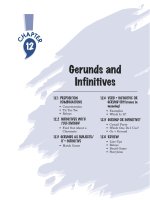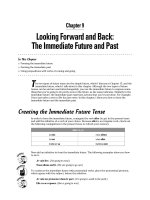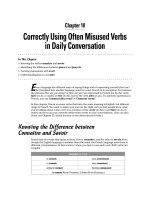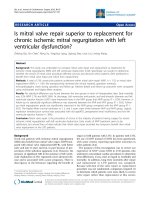Percutaneous mitral valve repair with mitraclip (technique and outcomes
Bạn đang xem bản rút gọn của tài liệu. Xem và tải ngay bản đầy đủ của tài liệu tại đây (2.19 MB, 36 trang )
Percutaneous Mitral Valve Repair
with MitraClip:
Technique and Outcomes
Michael J Rinaldi, MD
Sanger Heart and Vascular Institute
Carolinas HealthCare System
Charlotte, NC
Disclosure Statement of Financial Interest
Consulting Fees/Honoraria Abbott Vascular
Boston Scientific
Within the past 12 months, I or my spouse/partner have had a financial
interest/arrangement or affiliation with the organization(s) listed below.
Affiliation/Financial Relationship
Company
MitraClip MV Repair
• The only FDA approved percutaneous
therapy for MR in the US Anatomy and Etiology
• Degenerative MR
– Redundant leaflets, elongated
or ruptured chords
• Functional MR
– Annular dilation
– Annular calcification
– Papillary muscle dysfunction
• Fixed (LV dysfunction related
posterior tethering)
• Transient (ischemia)
• Rheumatic changes
• Endocarditis
Degenerative MR
Functional MR
MitraClip System
US Clinical Trial Experience
2003 2004 2005 2006 2007 2008 2009 2010 2011 2012
Surgical Candidates
High Surgical Risk
High Risk
Single-
Arm
Continued Access:
High Risk
EVEREST I
Feasibility Study
EVEREST II RCT
MitraClip vs. Surgery
Continued Access: Surgical
Candidates
N = 78
N = 273
High Risk Cohort
N = 351
N = 55
N= 279
184 clip
95 surgery
N = 272
EVEREST II Randomized Clinical Trial
Aug 2005 - Nov 2008
Randomized Cohort
N=279
Untreated
n=6 MitraClip
n=15 Surgery
MitraClip
N=178
Surgery
N=80
Median follow-up 4.93 years. 1,007 total patient-years of follow-up.
DMR
N=130
FMR
N=48
DMR
N=62
FMR
N=18
DMR MitraClip
80% Clinical F/U
5-Year Analysis
(N=104)
FMR MitraClip
85% Clinical F/U
5-Year Analysis
(N=41)
DMR Surgery
77% Clinical F/U
5-Year Analysis
(N=48)
FMR Surgery
83% Clinical F/U
5-Year Analysis
(N=15)
Withdrew 24
Missing 2
Withdrew 6
Missing 1
Withdrew 12
Missing 2
Withdrew 3
Missing 0
Overall Distribution
74% DMR
26% FMR
Safety
30 Day Modified * MAE Intent to Treat
0
10
20
30
40
50
Device Control
30 Day Modified MAE (%)
Major Bleeding Complication*
GI Complication
New Onset Atrial Fibrillation
Ventilation >48hrs
Urgent CV Surgery
Stroke
Death
8.3%
42.6%
*Major bleeding requiring transfusion ≥ 2U, or surgical intervention.
p
SUP
<0.00001
Device Control
Primary Effectiveness
Death
4.5%
6.7%
16.4%
6.8%
2.7%
2.7%
0%
10%
20%
30%
40%
50%
Event rate (%)
p=0.5260
p=0.3344
p=0.0026
Device Group (n=137)
Control Group (n=80)
Per Protocol Cohort
1
st
Surgery
MR > 2+
Re-operation
0
20
40
60
80
100
Baseline 12 Months
Percent Patients
0
20
40
60
80
100
Baseline 12 Months
MR Reduction
Baseline vs. 12 Months, Per Protocol
p<0.0001
1+
1+-2+
2+
4+
(n=119) (n=119)
Device Control
3+
2+
4+
3+
1+
1+-2+
2+
4+
(n=67) (n=67)
3+
2+
3+
0+
1+-2+
13.4%
36.1%
11.8%
33.6%
16.0%
17.4%
58.2%
8.7%
3.0%
18.4% (7/38)
Replacement
2.5%
p-value compares the distribution of MR grade in device with the distribution of MR grade in control at 12 months
(Fishers’ Exact test)
NYHA Functional Class
Baseline vs 12 Months, Per Protocol, Matched Cases
0
20
40
60
80
100
Percent Patients
97.6%
NYHA
Class I/II
87.9%
NYHA
Class I/II
n=124 n=66
I
II
III
I
II
III
IV
IV
III
II
I
II
I
Device
Control
Baseline Baseline 12 months 12 months
p<0.0001 p<0.0001
*p=0.0162
p-value compares the distribution of NYHA class at baseline to the distribution at 12 months within device and control
*p-value compares the distribution of NYHA class in device to the distribution in control at 12 months (Fishers’ Exact test)
Mitral Regurgitation Grade at 5 Years
N=85 N=34 N=21 N=7
p<0.005 p<0.005 p<0.05 p=0.82
N = survivors with paired data; p-values for descriptive purposes only
81% 100% 86% 86%
MitraClip
(N=130)
Surgery
(N=62)
MitraClip
(N=48)
Surgery
(N=18)
DMR FMR
4+
4+
3+
3+
3+
2+
2+
2+
1+
1+
0+
0+
0%
20%
40%
60%
80%
100%
BL 5 Years BL 5 Years
Patients (%)
4+
4+
4+
3+
3+
3+
3+
2+
2+
2+
2+
1+
1+
0%
20%
40%
60%
80%
100%
BL 5 Years BL 5 Years
Patients (%)
MitraClip System
US Clinical Trial Experience
2003 2004 2005 2006 2007 2008 2009 2010 2011 2012
Surgical Candidates
High Surgical Risk
High Risk
Single-
Arm
Continued Access:
High Risk
EVEREST I
Feasibility Study
EVEREST II RCT
MitraClip vs. Surgery
Continued Access: Surgical
Candidates
N = 78
N = 273
High Risk Cohort
N = 351
N = 55
N= 279
184 clip
95 surgery
N = 272
High Risk Cohort
30 Day Mortality
18.2%
11.3%
4.8%
0%
5%
10%
15%
20%
25%
STS or Surgeon-
predicted*
STS-predicted Observed
Mortality
Rate
*Protocol-specified
p < 0.0001
p < 0.0001
Matched Data
N=351
(30-day)
Source: EVEREST II High Risk Cohort
High Risk Cohort
MR Grade
Paired data (N=325)
4+
4+
4+
4+
4+
4+
3+
3+
3+
3+
3+
3+
2+
2+
2+
2+
2+
2+
1+
1+
1+
1+
1+
0+
0+
0
20
40
60
80
100
Baseline Discharge Baseline 1 Year Baseline 2 Years
Patients (%)
p<0.0001
Paired data (N=221)
p<0.0001
86%
83% 87%
p<0.0001
Paired data (N=109)
High Risk Cohort
NYHA Functional Class
Paired data (N=233)
IV
IV
IV
III
III
III
II
II
II
I
I
I
0%
20%
40%
60%
80%
100%
Baseline 30 Days 1 Year
Patients (%)
p < 0.0001 p < 0.0001
83%
86%
18%
So Where Are We Now?
Ventricular
element
Atrial
element
Worldwide Experience Using
the MitraClip
*Data as of 8/31/2014. Source: Abbott Vascular
Study Population N*
EVEREST I (Feasibility) Feasibility patients 55
EVEREST II (Pivotal) Pre-randomized patients 60
EVEREST II (Pivotal) Non-randomized patients
(High Risk Study)
78
EVEREST II (Pivotal) Randomized patients
(2:1 Clip to Surgery)
279
184 Clip
95 Surgery
REALISM (Continued Access) Non-randomized patients 899
Compassionate/Emergency Use Non-randomized patients 66
ACCESS Europe Phase I Non-randomized patients 567
ACCESS Europe Phase II Non-randomized patients 286
Commercial Use Commercial patients 14,232
Total
16,427
*As of 8/2014
Case Example
• 45yo M with a month of progressive SOB
and abdominal pain
• AF with RVR, elevated LFTs, INR 2, Cr 1.7
• TTE severe MR due to P2 flail with EF 35%
and RV failure
• Cath CI 1.5, wedge 30 with V 45, PA systolic
64, coronaries patent
• IABP placed and transferred
Sub-Acute MR with Shock
• Given severe RV failure and multi-organ
failure his operative mortality was felt to be
too high for conventional surgery
• MitraClip for Sub-Acute MR with shock?
Sub-Acute MR with Shock
Transseptal Puncture
Bicaval
View
SAX
Clip in LA – LVOT view









